 Be Prepared
Be Prepared
A book for boys who are interested in the game of Scoutingby Brother John M. Wilcott
This book is dedicated to BROTHER JOSEPH, D.S.C. and to his Scout Lenders and Scouts of the Makwiro District, where I enjoyed the game of Scouting for many years.
Dear New Scout
On my tenth birthday, my dad bought me a marvellous book, "Scouting for Boys". Bookworm that I was even them, I read it through in three days, and then lent it to my best friend, Yvon. He was more the outdoor type then I: about 1% "read", 39% "talk" and 60% "do". I guess I was nearer 40% "read", 10% "talk", but still a good 50% "do"! Between the two of us, we soon had learned all the knots mentioned in the book, organised tracking and stalking games, taught ourselves morse, in short we actually did all we could do or adapt from this book. There was no Scout in our village; I had in fact never seen a live Boy Scout. No adult we approached in our keen, and possibly childishly boastful way, would accept to help us, partly put off by the fact that Scouting was all new to them, and partly frightened by our efforts to prove that WE knew all about it.
So we carried on playing at Scouting with other friends whom we roped in and called "patrols", and we had a great time of it, with no more elaborate equipment than bits of rope, one or two clasp knives, a rather erratic 10—cent compass, and the felling axes which all our parents owned and which we frequently used at home anyway to prepare firewood for the winter.
It is only many years, and very many books later that I realised we had after all merely duplicated in the late 30's in our small Canadian village what had been very common in England when "Scouting for Boys" first appeared in 1908.
Anyway, although I first joined the Boy Scouts Association officially only at the age of 27, I like to consider myself as having been one of Baden—Powell's Scouts since the age of lO, whatever my official record of service may say.
Today, a Rhodesian boy who is interested in Scouting is a lot luckier. Thanks to easier communications, even the most remote parts of the country have heard of Scouting, and a great number of adults accept to guide boys through this most wonderful game.
There are already a number of first class books which every Rhodosian boy, whatever his race, should read, and will I am sure enjoy, whether he is a Scout or not. "Scouting for Boys", although written more than 60 years ago, has been adapted to our days and still has all the interest it had then. Scout Leaders can read Claude Cook's "Good Scouting", and George Witchell's "A Book for Scout Leaders" which has been published in this country in a version adapted to Rhodesian rural conditions.
So, why another book? Purely in the hope that it will reach a few more boys. And more precisely, this book is meant to help actual Scouts through their first few months in the Troop.
It covers all the present tests of the "Scout Badge" and the "Basic Scout Standard". It also covers some topics which may not be part of the formal tests, but which every Scout must know.
My heartfelt hope is that you will enjoy it . . . and finish it wanting to know more.
Good Scouting,
Brother John M. Wilcott
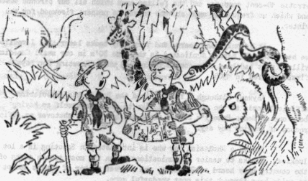
"I know you are good at compass and mapping,
but are you quite sure we are within ten minutes of Ruwa Park?"
GET YOUR CRAYONS. This booklet contains ever 50 pictures. You can
make it much more attractive if you colour them all.
THE FOUNDER
Robert Stephenson Smyth Baden—Powell
Born 2nd February 1857
Died 8th January 1941
Baden-Powells story is a very thrilling one. Buy or borrow one of the numerous books which tell it: you will not regret it.
I mention here only a few of the highlights of his rich life which you ought to know about. Your Scout Leader can tell you more. Ask him especially more details about the stories illustrated.
 THE COPSE
THE COPSE
Baden—Powell was born in London. His father was a clergyman and a professor at Oxford University. The boy did his Secondary School at Charterhouse, with Dr. Haig Brown as Headmaster. When this school was moved from London to Godaiming, B.P. enjoyed thoroughly the wider space and the woods. He liked particularly a bolt of wood and wilderness called The Copse, where he would often retire to observe wildlife, snare rabbits and hares, and cook them over a smokeless fire.
|
HOLIDAYS
During the holidays, B.P. often joined his elder brothers in cruises at sea or on the Thames. The oldest, Warrington, was captain, and a skillful seaman indeed. B.P. has often written of the great times they had on such expeditions, even when storms or cliffs put them in serious dangers.
 ACTING
ACTING
Another of young Stephenson's favourite hobby was acting. He had a natural talent for it, improved his porformance through practice, and observation of more experienced actors. A skill that he will use to the full later.
|

Pig-sticking, even where the horse can't go.
|
INDIA
At 19, he passed an entrance examination for the Army, and sailed to India in September 1876. He was to spend a total of ten years in this country, and thanks to his high spirits, he "brightened up the life of the regiment considerably". He took an active part in theatricals and concerts. He trained his own horses for such sports as polo and pig sticking. The latter could be very dangerous indeed. He organized games for the children and trained them to be observant. Meanwhile, he kept improving his skill as an army man: he was particularly efficient at surveying and scouting.
|

Survey of the Drakensberg
ZULULAND
From India, he was sent to South Africa, where he did a 600—mile journey on horseback, disguised as a journalist, to survey the best route his regiment could follow over the Drakensberg.
|

Playing Polo in India
|
A S H A N T I
In 1895, he went to West Africa. King Premph of the Ashanti was notorious for burtality, human sacrifices and slave trading. B.P. organised the local inhabitants to make a 150—mile road to Mumasi, the capital of Ashanti. When they realized that the army could then reach their capital easily, the Ashanti surrendered without a fight.

The road to Kumasi
M A T A B E L E L A N D
He was in Rhodesia during the Matabele rebellion. This campaign called out his finest skill since the Matabele were expert scouts themselves. At night, he often went off prowling among the Matopos Hills to study their intricate paths and passes. The Matabele called him Impeesa, and respected him greatly. He even found time for lion hunting to help a friendly tribe.

Lion Hunt in Matabeleland
After the rebellion, he went back to India where he started training army scouts. In 1899, he published in England the book, "Aids to Scouting" for the training of army scouts.
M A F E K I N G
He was sent to South Africa during the Boer War. He organized the defense of Mafeking which held out against repeated attacks for 217 days. This is where B. P. organised a "Cadet Corps" of young boys under twelve-year-old "Sergeant-Major" Goodyear to act as messengers and orderlies.
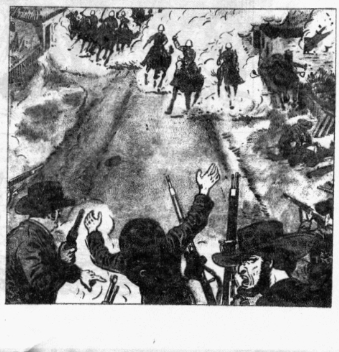
Boer attack on Mafeking.
After the war, B.P. stayed in South Africa for a while to recruit and train men for the South African Constabulary.
In 1903, he became Inspector General of Cavalry, a position which brought him to many countries of the world.

Calvary Charge.
B R O W N S E A I S L A N D
In 1907, he began re—writing "Aids to Scouting" to adapt it to boys, since he had discovered that many boys were using his army book for games, training and activities. He organized an experimental camp on Brownsea Island in July 1907 to test his ideas. The twenty boys who took part loved it, and, unknown to B.P. Scouting had started.
SCOUTING FOR BOYS
He published "Scouting for Boys" in 1908, in six parts. It had to be reprinted five times that first year. Boys formed themselves into troops in England, as well as in Australia, Canada, New Zealand and South Africa. Already in 1909, a Scout Rally brought 11,000 British Scouts together in London. Chile, the United States of America, Guyana and India started Scout troops. By the end of 1910, there were 100 300 Scouts and 7690 Scouters in England alone.
Meanwhile, the younger boys wanted Scouting; so he prepared a scheme for the "Wolf Cubs" (now called Cub Scouts) based mostly on Kipling's "Jungle Book". The girls wanted Scouting: so he adapted the boys' scheme to "Girl Guides' Companies". And so on for Rovers, Senior Scouts, Brownies, Sea Scouts, Air Scouts, Rangers, etc.
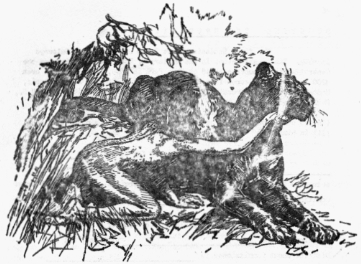
Mowgli and Bagheera.
WORLD SCOUTING
In 1916, Gilwell Park was donated to the Boy Scouts Association and become a camp site for Scouts, and the International Centre for Scout Leader Training. In 1920, Scouts from 21 different countries met in London for the first World Jamboree. In the following years, B.P. was very busy visiting Scouts all over the world.
Today, there are over 10 million Scouts in 87 different countries. The Headquarters of the World Scout Bureau are now in Geneva, Switzerland.
SCOUTING IN RHODESIA.
The first Rhodesian Scout Troop was started in Bulauayo in 1909. The biggest event in the history of Rhodesian Scouting was the Central African Jamboree, held at Ruwa Park in 1959, which gathered over 1200 Scouts of all races from Rhodesia, Tanzania, Congo, Malawi, Zambia, Mozambique, Botswana, South Africa, Lesotho, Swaziland, Britain, the U.S., Pakistan and Sweden.
(In the next paragraphs, I am leaving some blanks which each Scout must fill in himself.)
The Chief Scout Commissioner for Rhodesia is ____________________. Rhodesia is divided into five Scout Provinces. We belong to the __________ Province. Our Provincial Scout Commissioner is ______________.
Each Province is divided into a number of Scout Districts. We belong to the _________ District, and our District Scout Commissioner is ________________.
A Scout Group can be made up of a Cub Pack (8 to 11 years old), a Scout Troop (11 - 16), and a Venture Scout Unit (16 — 19). In our Scout Troop, the Scout Leader is _________ and the Assistant Scout Leaders are ______________________.
A Scout Troop is made up of Patrols. The Patrol is always the basic unit for most Scout activities. I belong to the ___________ Patrol, and my Patrol Leader is ________.
There are now over 10 300 Scouts in Rhodesia, 7800 of whom are Africans.
+ + + + + + +
|
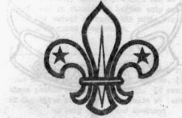 THE SCOUT BADGE
THE SCOUT BADGE
Magnetic compasses, particularly the bigger ones on board ships, usualy have the North point marked with the "fleur-de-lis" (heraldic lily).
The compass shows the way. So too, the Scout wears this "fleur-de-lis" as a badge to remind him that he is expected to show the way by doing his duty and helping others.
The ship's compass displays this emblem as if to say " You can rely on me. I am here to show you the way."
The Scout wears the same emblem to suggest the same thing. "You can rely on me. I am at all times willing to help and I do my best to behave in such a way that you can take me as a pattern. Whereever you see a boy wearing this badge, you can trust him: he shows you the right way to live."
So you see, as a Scout you really take on a heavy responsibility. A lot is expected of you. Make sure you always bring honour and credit to the Scout Badge you wear.

This is a fine time to start reading the instructions.
THE SCOUT M0TTO
After the Boer War B.P. recruited and trained the South African Constabulary. The men wanted a motto, and chose, "Be Prepared" for two main reasons:
first it described so well their purpose — to train themselves so well that they would never be taken by surprise; secondly, it had the some initials as their beloved leader whom they were glad to honour in this way.
 When B.P. later wrote "Scouting for Boys", he could think of no better motto for his "peace Scouts" than the one adopted by his army scouts.
When B.P. later wrote "Scouting for Boys", he could think of no better motto for his "peace Scouts" than the one adopted by his army scouts.
 A Scout trains himself in knotting, first aid, compass & mapping, and lots of other thrilling activities because he always wants to be prepared to face any difficulty, emergency or accident that may occur. "He knows exactly what to do- when anything unexpected happens." (Camp Fire Yarn No. 2)
A Scout trains himself in knotting, first aid, compass & mapping, and lots of other thrilling activities because he always wants to be prepared to face any difficulty, emergency or accident that may occur. "He knows exactly what to do- when anything unexpected happens." (Camp Fire Yarn No. 2)
The motto is printed above on a scroll upturned to look like a smile, because a Scout always does his duty willingly and with a smile.
The knot below the scroll is also there for a purpose. Many people, when they want to remember something, tie an overhand knot in the corner of their handkerchief, or even in their tie. Scouts used to make a knot in their
scarf to remind them to do a good turn daily. This custom is dying out, especially because you must not do good turns only when you wear your scarf, and it should not happen only once a day anyway. But a knot is added below the scroll carrying the Motto for the same purpose: A Scout thinks of doing good turns frequently.
THE SCOUT SIGN
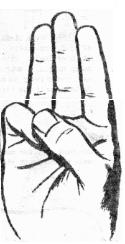 We have a special sign, used by scouts all over the world: three fingers held like the three points of the Scout Badge. It reminds us of the three parts of the Promise we take:
We have a special sign, used by scouts all over the world: three fingers held like the three points of the Scout Badge. It reminds us of the three parts of the Promise we take:
1. Duty to God and country;
2. Help others;
3. Keep the Scout Law.
The thumb and little finger are joined, and, with the hand, form a circle which I like to think of as enclosing all the scouts of the world in one great family.
When scouts shake hands, they do so with the left hand. This will also identify you as a scout anywhere in the world.
THE SCOUT SCARF.
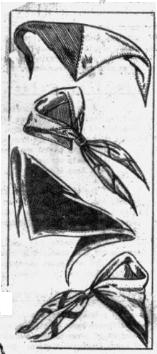 Scout uniforms vary tremendously in different parts of the world, but the scout scarf seems to be a common feature of every Scout Association. On a hike or in a camp, it can be used as a triangular bandage in an emergency. Use it also as head gear if you have forgotten your hat or lost it.
Scout uniforms vary tremendously in different parts of the world, but the scout scarf seems to be a common feature of every Scout Association. On a hike or in a camp, it can be used as a triangular bandage in an emergency. Use it also as head gear if you have forgotten your hat or lost it.
But these are emergencies. Normally wear your scarf, and indeed your whole uniform, very smartly. Your scarf is held with a woggle which I hope you have made yourself out of string, leather, bone, wood, etc. (see the last page for suggestions).
THE SCOUT STAFF
 When Baden—Powell was in Ashanti, he noticed that his Chief Engineer always carried a long staff marked in feet and inches and he adopted this idea for his Scouts.
When Baden—Powell was in Ashanti, he noticed that his Chief Engineer always carried a long staff marked in feet and inches and he adopted this idea for his Scouts.
The Scout staff has hundreds of uses, and marking it adds to its usefulness. With Rhodesia going metric, I suppose you will mark yours every 10 cm., Subdividing only the first ten cm. into centimetres.
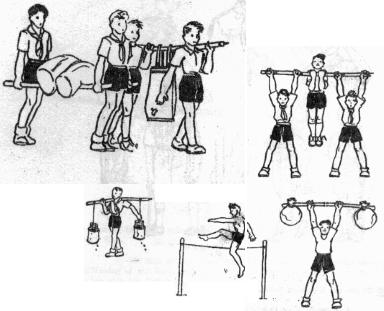
THE SCOUT SALUTE

HOW is it done? Look at the person you salute full in the face, bring your right arm smartly up, thimb and little finger touching, the "Scout three fingers" straight, to touch the brim of your hat (or where the brim would be if you had a hat), then bring your arm smartly down.
When saluting the flag, look at the flag.
When carrying a staff in your right hand, salute by bringing the left hand ("Scout three fingers") smartly across your staff, then down again. Arm bent at right angle, touching the staff at right angle.

 When do you use the Scout salute?
When do you use the Scout salute?
1. A Scout in uniform always salutes another Scout or Scouter, whether the other is in uniform or not.
2. Salute the flag when it is being broken, agreeing with the person breaking it.
DO NOT salute when the flag is being lowered: simply stand at the alert.
YOU MAY use the Scout Salute, even if you are not in uniform, when greeting another Scout or Scouter. Many Scouts prefer to give only the Scout Sign when they are not in uniform: keep the elbow elbow touching the body, raise the right hand to shoulder height doing the Scout Sign.

Which of those two do YOU look like when you are in uniform?
YOU MUST do the Scout Sign (NOT the Salute) during the making or reaffirming of the Scout Promise. If you are carrying a staff, you do this Scout Sign with the left hand.
DRILL MOVEMENTS
Scouts are not some sort of junior soldiers, but they certainly must be smart and well drilled. "Alert", "Easy", "Salute" are commands that must be obeyed together and smartly. Other movements must be practised often.
If you wear a hat or a beret, wear them properly!
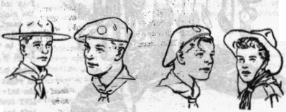
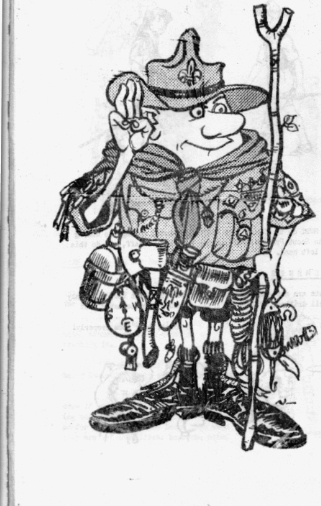
QUICK MARCH.
All step off together with left foot taking a full pace forward. Scouts should use the quick step of 120 paces to the minute. The arms should not be bent and should swing naturally fron the shoulders when marching.
HALT. Give the command as the right foot passes the left. Take one more pace with the left foot and bring the right foot up smartly, bringing the arms and body to the position of the Alert.
RIGHT TURN. Turn on right heel with the help of left toe.
LEFT TURN. Turn on left heel with the help of right toe.
ABOUT TURN. Turn on right heel, keeping arms close to the body.

THE SCOUT PROMISE
Among the knights of the Middle Ages, among the Red Indians in America, among most tribes in Africa, boys had to prove themselves before their own people before they were allowed to win higher awards. The tests they had to go through were sometimes very long and gruelling; not all of them made it. In some cases, in fact, only the fittest managed to survive the ordeal.
As a Scout, you must also prove yourself before being invested. The tests are very easy and no Scout need wait more than a couple of weeks before taking his Promise. The only thing that is expected of you is really that you know what you are doing. You must realise clearly what you are publicly promising to do. The Scout Promise is important and no boy should take it unless he sincerely means to keep it.
 ON MY HONOUR,
ON MY HONOUR,
I PROMISE THAT
I WILL DO MY BEST
TO DO MY DUTY
TO GOD
AND MY COUNTRY,
TO HELP OTHER PEOPLE,
AND TO KEEP THE SCOUT LAW.
I shall mention "honour" when we come to the Scout Law.
You promise to your BEST. Your Scout Loader and your fellow Scouts will not expect you to be perfect straight away, but they WILL expect you to try your utmost, and to show some noticeable progress as you get more Scout badges. To pass numerous tests is good and important. To keep your Promise better, and better is more important still.
Now let us think over the various points of our Promise.
GOD I once lead a Troop which included Catholic, Anglican, Methodist, Moslem and Hindu Scouts. Scouting is not attached to any one Church, and unless you belong to a Church—sponsored Group, you are likely to meet with boys of different denominations. This does not mean that Scouting is indifferent to religion. Quite the contrary! Baden—Powell made "Duty to God" the very first point of the Scout Promise. A true Scout makes it a point to know all he can about his own Church, and to attend its services regularly. (If your parents do not belong to any religious body, speak to your Scout Loader about it: he will be only too willing to guide you). There exists a special badge for Religious Knowledge. You will, I hope, soon be proud to wear it.
As Christian Scouts, we like to think of the boy Jesus as our first brother Scout, who is for us at the same time a model and a friend, and who has the poser to help us. We like to repeat frequently and piously the "Our Father", the best of all prayers since he himself taught it to us, his disciples.

Join with devotion in the prayers said at the beginning and at the end of Troop meetings, start and end your day with a short and sincere prayer, say grace before meals, and take an active part in the Scouts' Own that will be held in your Group.
We pray to adore God, to ask him forgiveness for our sins and those of our friends and neighbours, to ask him favours and protection, to thank him
for his care of us.
We pray alone and silently. We pray in public in union with the members of our Church. We pray together as a Scout Troop. All those forms of prayer are needed.
This is how we fulfil the first and most important part of our Scout Promise: Duty to God.
COUNTRY Scouting is not political and does not support any political party. Neither does Scouting favour one form of government over another. No Scout in uniform may at any time be used to distribute leaflets promoting a political party, or generally to canvass, however indirectly, support for any party. No Scout or Scouter may attend a political meeting in uniform.
So much for the negative side. "To do my duty to my country" means a
lot more than that, and all of it positive.
A Scout accepts the laws of the country. No country can hope to exist
for long without law and order. This includes laws which may seem of little importance, or laws we don't like, just as well as those laws which present no personal problem to us.
A Scout respects and honours the rulers of his country, because they are in authority and a Scout accepts and supports, authority.
A Scout respects and honours the Rhodesian flag. In every country of the world, the flag is recognized as the main symbol of the country and
every Scout knows that whon he salutes his country's flag, he is merely showing his pride of being a Rhodesian. In your Troop, I hope a high standard of tradition and reverence is maintained for all flag ceremonies.

In Scouts' Own and other common prayers, Scouts often pray for their country and its rulers.
Scouts make a special effort to know the Highway Code, especially where pedestrians and cyclists are concerned, and follow it in all points.
Litter spoils the beauty of Rhodesia and makes it a less healthy place to live in. Scouts are careful to throw litter only in bins or pits where it will be burned, burried or cleared, and help willingly in clearing litter scattered by people less conscious of their civic responsibilities.
Know the History of Rhodesia, and as a Troop, arrange if you can make some visits to her main natural and historical attractions. We are indeed lucky in that Rhodesia has such a great variety of beautiful natural scenery to offer.
Older Scouts must learn how Government, elections, rates, law, etc. works. This can, and must, be done without getting involved in party politics.
Help Others The Good Samaritan, not only showed himself willing to serve a stranger and enemy of his race, but knew the right treatment to give and did not rest until he had completed the job.
This is exactly what a Scout has in mind when he promises "to help other people".
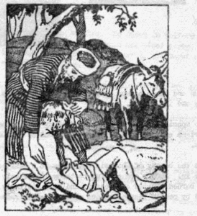 1. Be willing to help, ready to give of your time and
effort to help others, sometimes by yourself, or with another Scout, or with your Patrol, or occasionally with the whole Troop.
1. Be willing to help, ready to give of your time and
effort to help others, sometimes by yourself, or with another Scout, or with your Patrol, or occasionally with the whole Troop.
2. Train yourself to acquire the necessary skills to be really helpful. A badly performed Good Turn is useless to the receiver, however willing you may be.
3. The first place where a Scout is willing to help is at home.
He is a sorry Scout indeed who is prepared to help everybody except his own father and mother, brothers and sisters. A true Scout is useful at home and helps and helps cheerfully, without hoping for, without even accepting, any reward.
4. Next in order of importance cme your school mates, your Troop, your friends. Some Scouts find it easy to help those than to help at home. Any Scout worthy of the name will of course think of his home first.
5. In the spirt of the Good Samaritan, a good Scout makes a special effort to help this or that boy whom he does not like very much, for example to help some Scout of that Troop who beat us at the last competition, that class mate who is forever nagging him because he is a Scout, etc. I am sure you can think of a list of people whom you would not help "for all the money in the world". All right. Don't help them for money or for any other reward, but do help them when you can because you have taken a Promise and you mean to keep it even when it is not easy to do so.
TO HELP OTHERS. This is truly the Scout Spirit. It is understood in your motto, it is in your Promise, it is repceated in your Law. All the skills you will learn in Scouting have in short, but one aim: to help others more efficiently.
The Scout Law "To keep the Scout Law does not mean to sit down passively in a state of goodness brushing up your halo..."
(Rex Hazlewood)
"A Scout is active in doing good, not passive in being good." (B.P.)
I shall not give long comments on each point of the law. You have other ways of coming to a good understanding of it:
(i) Your Scout Leader will explain it to the Troop through short talks, yarns and stories.
(ii) Read "Scouting for Boys". The short explanation of B.P. himself is still the best I have seen anywhere.
(iii) Discuss it with your Patrol. To help you, here is a suggestion. On pages 31 to 35, you will find ten pictures with titles next to them, one each for the ten points of the law. You must choose one at a time and make up a story to illustrate the law quoted and at the same time to fit the picture: this picture must represent a key happening in your tale. Set your place and time to match the costumes and other details illustrated. Once you have thought up a good one, tell it to the Troop at a campfire, or at a Troop meeting. If it goes down well, write it and send it to me (c/o P.O. Box 669., Salisbury). I shall be delighted to read it, and I may print the best ones later. (Don't forget to give your name, address, age and Troop.)
(iv) Best of all, look at the older Scouts in the Troop. They have been improving their understanding and practice of the law for many months and will provide you, by the way they live, with the best explanation of all. Careful here! Don't try to catch them in not keeping the Law; rather look for those actions and attitudes which show they know their Law, think about it often, and keep it. Those are the ones you must try to emulate.
1. A SCOUT'S HONOUR IS TO BE TRUSTED. If anyone tells you, "I don't trust you," this is the biggest insult possible. A Scout is proud of
being truthful and honest, and is greatly insulted if anyone doubts him. Of course, such trust must be deserved. A boy who lies, or cheats, or does not carry out an order when trusted on his honour to do so, should hand over his Scout Badge and cease to be a Scout.
2. A SCOUT IS LOYAL TO HIS COUNTRY, HIS PARENTS, HIS SCOUTERS, HIS EMPLOYERS, AND TO THOSE UNDER HIM. He obeys them willingly, serves them faithfully, fully and honourably, sticks to them against anyone who talks badly of them.
3. A SCOUT' S DUTY IS TO BE USEFUL AND TO HELP OTHERS. Between two things, always choose what is best for other people. Know your Scout skills very well so as to be truly useful. Do Good Turns "without being found out": they are the best.
4. A SCOUT IS A FRIEND TO ALL, AND A BROTHER TO EVERY OTHER SCOUT.
A Scout is never a snob. Friend and brother first of all to those with whom he lives daily, to the Scouts of his own Troop. A Scout does not agree with wrong opinions or evil actions, but he is still friendly even to those he has to disagree with.
5. A SCOUT IS COURTEOUS. This includes politeness, good manners, thoughtfulness, cheerfulness towards all, especially to those weaker than yourself: the old, the sick, women, children.
6. A SCOUT IS A FRIEND TO ANIMALS. Take good care of your pets. Study the habits of animals, you will then like them better. Do nothing that
could harm them, through cruelty, or even through litter and pollution of rivers and campsites. This indeed can be quite harmful to humans as well.
7. A SCOUT OBEYS ORDERS OF HIS PARENTS, PATROL LEADER OR SCOUT
LEADER. You may ask questions to get a clearer idea of what you are told to do, not to show unwillingness to obey. In an emergency, unquestioning and immediate obedience may be vital; and a Scout trains himslef for that: he wants to be prepared.
8. A SCOUT HAS COURAGE AND IS CHEERFUL IN ALL DIFFICULTIES. Face
difficulties. Grousing, whining, grumbling solve nothing. If things go wrong, check first whether it did not hpppen through your owm carelessness:
this will be the case very often. Even rain in camp and a burned stew can be borne cheerfully if you have the proper Scout spirit.
9. A SCOUT IS THRIFTY, HE MAKES GOOD USE OF HIS TIME AND TAKES PROPER CARE OF POSSESSIONS AND PROPERTY. "A stitch in time . . ."
Thrifty, not mean: Whip the end of that rope, switch off that light, oil this axe blade, repair that tent at once, etc. And if you have lots of pocket money, save all you can.
10. A SCOUT IS CLEAN IN THOUGHT, WORD AND DEED. Clean body, clean uniform, clean meeting place, clean campsite go hand in hand with clean
thinking, clean talk and clean behaviour. Bad language is not heard among Scouts. As regards questions of sex, a Scout must be sincere and informed. Discuss your questions and problems, preferably with your parents, also with your Scouter or some other responsible adult, not with other boys: they are not better informed than you are, and such discussions between boys usually turn to dirty stories. The best way to be clean in thought is to keep healthy, active and busy, and to pray sincerely and frequently.
Rhodesian Flag The Rhodesian flag consists of three vertical stripes of equal width of green, white, green. On the white stripe is the Rhodesian Coat of Arms. The length of the flag is twice its breadth.
THE RHODESIAN COAT OF ARMS.
The Coat of Arms is made up of: —
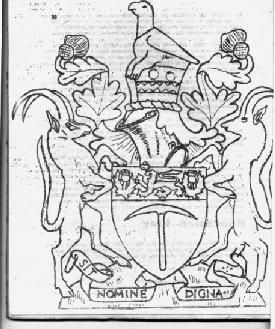 a/ A gold pick (for mining) on a green background (for agriculture) which form the central shield;
a/ A gold pick (for mining) on a green background (for agriculture) which form the central shield;
b/ Above the shield, a red lion between two green thistles with purple flowers. This comes from the Coat of Arms of Rhodes' family;
c/ Two sable antelopes which support the shield;
d/ Above the shield, a knight's helmet decorated with gold and green loaves;
e/ On top of the helmet, the Great Zimbabwe bird;
f/ At the bottom of the Arms, the motto of Rhodesia, "Sit Nomine Digna" (May she be worthy of the name.)
You must be able to draw the coat of arms in colour.
HISTORY OF THE COAT OF ARMS.
+ It was granted to Rhodesia by Royal Charter on the 11th August 1924.
+ The Great Zimbabwe bird is a figure that was discovered at the Great Zimbabwe ruins. It was carved in soapstone and has become recognized as an emblem of Rhodesia.
+ Rhodes' Arms (Lion and thistles) were included. Also the shield to represent the two main industries of the country: mining and agriculture.
+ The Sable antolopes are typical of Rhodesia. They have replaced the mythical unicorns which are traditionally used in heraldry.
FLAG CEREMONIES.
The flag is usually broken at the beginning of every Scout parade and each morning at camp; it is lowered at the end of parade, and each evening in camp.
To prepare the flag, fold it lengthways into two, and then two again. Roll it up from the fly (the end without the toggle) towards the hoist (the end with the toggle). Now pass the rope on your flag round the rolled—up flag and tuck in the end of the rope under itself. Then join the halyard to the toggle with a bowline. Hoist the toggle end until it is up against the pulley.
For breaking, all present are brought into the horseshoe formation round the flag. Order, "Troop . . . alert!" Then the duty P.L. pulls downwards on the halyard smoothly, and the flag should break easily. The P.L. then takes one step backwards and salutes the flag. All the Scouts present salute with him.
Later, when the parade is over, the duty P.L. comes back to fix the
halyard to the pole.
To lower the flag in camp, the duty P.L. marches to the flagpole and sounds the Troop call. All Scouts stand alert wherever they are. The P.L. lowers the flag slowly. Then a second call, and life carries on as before. Fold the flag ready for tomorrow and hand it over to the next duty P.L.
At the end of a Troop meeting, same procedure, but the Scouts may be
assembled. It gives the opportunity for final prayers and notices.
ROPEWORK

To add new fiber, twist the additional lengths into one strand, make cord past the splice and then add new fiber to the other strand.
MAKE A ROPE.
Undo two or three inches of an old rope to understand how it is made. Notice how each strand is twisted one way, and then the three (or four) strands are twisted together the other way. Notice the length of the fibres that make up the strands. The longer the fibres, the better the rope.
Try and make a rope of your own. First, you want some fibre: sisal, fibrous bark, even grass; or if you live in town you can use thin cotton thread although this is not so "Scout—like" as a natural fibre (but it will still help you find out how a rope is made).
Pull as you twist to make three strands. Add new fibres as you need them, one at a time. And then, twist the three strands together, still pulling all the time. It takes a lot of patience to make a good rope of even thickness,
but a Scout is a lot prouder of a rope he made himself, even if it does not look quite so nice as one bought.
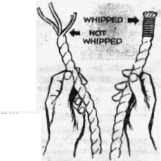 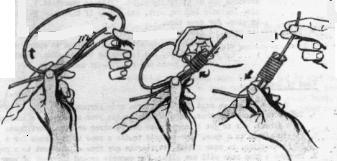
WHIPPING A ROPE
Use about 2 feet of string. First make a loop. Hold it at the end of the rope.
Wrap string tightly around rope - over the string ends. Make lots of turns around the rope.
Then pull the 2 string ends hard to tighten the whipping. Trim off the ends.
W H I P P I N G
You lose many inches of your rope if you don't whip it when you first get it, and keep re—doing the whipping as soon as it gets loose. The illustration' above shows you a simple way of doing this.
K N 0 T S
Scouts like doing knots properly. In fact, they like doing everything they try properly! I suppose anybody could invent a knot. If you twist and mix two ropes together long enough, they might finally hold But those who invented the best knots are the sailors. You will understand easily that in the old days, when they had to tie the sail to the mast, or to tie two ropes together on a ship tossed every which way by a storm and a raging sea, the knot had to be easy to make, It had to hold, and it had to be easy to undo under difficult conditions. So we can trust the sailors and learn their knots rather than invent our own messy ones.
The Perfect Knot
I mentioned above the three qualities of the perfect knot: 1. it is easy to do, 2. it holds, 3. it is easy to undo.
1. It is easy to do. When you learn a knot, practise doing it with one hand,
or in the dark, or even while others push you about.
2. It holds. If you choose the right knot for the right job, it will hold
provided you do it really tight. (This is important.) This
also includes locking neat, especially if that knot is to stay
in place for some time.
3. It is easy to undo. It good knife makes every knot, however complicated,
very easy to undo! But this method is rather expensive on rope, and is nothing but a defeat. Practice
undoing knots under difficult conditions.
Uses of Knots.
At this stage, we want knots for three main purposes:
1. To tie two ropes together. For example to tie your shoelaces, a bandage,
a parcel. Or to get a longer rope out of three or four short ones.
2. To tie a rope to a spar. For example to tie a rope to two trees for a
clothesline, to moor a boat, to tie the guy rope of the tent to a peg.
3. To make a loop that will not slip. For example around the neck of your
dog, around yourself to help you climb a tree or a cliff, around a wounded person whom you want to pull out or water, lower down a tree or a cliff, etc.
What knots do the sailors use in these cases?
1. TO TIE TW0 ROPES TOGETHER.
 We learn two knots for this purpose. The one on the right is very easy to do (Quality 1), very easy to dundo (Quality 3), and does some jobs very well (Quality 2). It is the best knot for bandages because it is flat.
We learn two knots for this purpose. The one on the right is very easy to do (Quality 1), very easy to dundo (Quality 3), and does some jobs very well (Quality 2). It is the best knot for bandages because it is flat.
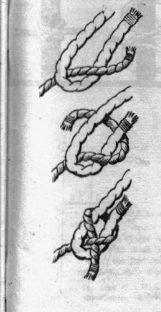 The one on the left is slightly harder to do, holds better especially
if your ropes are of unequal thicknesses.
(Note that the bigger one is only bent; the thinner one travels around.) It is very easy to undo.
The one on the left is slightly harder to do, holds better especially
if your ropes are of unequal thicknesses.
(Note that the bigger one is only bent; the thinner one travels around.) It is very easy to undo.
The first one is called a "reef knot", the second, a "sheet bend". I mention the names last because this is where they belong. Not much use knowing the NAME of a knot if you can't do it!
The reef knot can be made to slip, and is then called "slipped reef". This is very useful for some jobs, particularly for tying your shoelaces. In the sheet bend, the thin rope can also be "slipped". (See a slipped reef
on top of page 44.)
2. TO TIE ROPE TO A SPAR
The knot below is very easy to do and to undo. It does a good job in some cases, especially when the spar is rough and therefore
provides friction, and when the tension on your rope will be steady. If there are going to be jerks, rather use the one at right. (round turn and two half-hitches). Nearly as easy undo, it will hold better in most cases. Which one would you use to tie this swing to a branch?

Which one for this stone anchor, supposing your stone is very rough? The first knot is called a "clove hitch", the second, "round turn and two half hitches".
3. TO MAKE A LOOP THAT WILL NOT SLIP.
It takes a little practice to do it well, it does the job perfectly, and is easy to undo. So we teach only one: it is called the "bow—line".

Here I want to repeat two things:
1. Pull them TIGHT! Otherwise, all I said about "holding" and "doing the job" does not hold any more. Pull them T I G 11 T !.
2. The name of a knot is of little importance. I never ask my Scouts,
"Do a clove hitch", but I might well ask them, "Tie your rope to your neighbour's left ankle, and leave it to them to decide which is the best way. (In this case, I would prefer the bowline so as not to hurt the neighbour... "A brother to every other scout".
First Aid
Wash a small cut with TCP and water. Let it bleed a little, it'll soon stop.

In First Aid, there are two things you must know very clearly from the very start:
1. Sunnon adult help.
2. Care for simple wounds.
1. SUMMON ADULT HELP.
The very first time you start learning First Aid, it is very, very important that you understand your limitations. Even later, when you know more about First Aid, it will remain true that (a) you are a boy, (b) whatever "aid" (help) you give is only FIRST aid. An adult or a doctor will decide what to do next.
Scout First Aid will not make a doctor out of you. If ever you think of yourself as a kind of boy—doctor, you will be positively dangerous. In an accident, if an adult is present, he should take charge. If none is present, one boy should stay with the wounded while another goes to summon adult help.
2. CARE FOR SIMPLE WOUNDS.
 Three things to do in this case:
Three things to do in this case:
(1) Clean your hands.
Wash them thoroughly with soap, or clean them with a diluted antiseptic.
(ii) Clean the wound.
Remove foreign bodies (dirt, grass, etc.) that come out easily. With cotton wool and pure water (or a very diluted antiseptic), clean the wound itself. Do NOT rub the wound. Then clean the skin around the wound, washing AWAY from the wound.
(iii) To keep the wound clean, apply a dressing.
Put gauze, or lint (smooth side on the skin, fluffy side away), or any WHITE, CLEAN cloth on the wound. Put come cotton wool over. Bandage with plaster, or a roller bandage, or in an emergency, with any WHITE, CLEAN cloth.
If you have them, use a ready-made antiseptic dressing.
Compass

You can make your own compass. Ask your Scouter to show you page 8 of "A Book f or Scout Leaders" where a method is described. It is easy to do, and it works well.
The magnetic needle of the compass points North. Once you know where North is, you can easily know the other points:
North—East, East, South-East, South, South—West, West, North—West.
Make sure you hold your compass horizontally, so that the magnetic needle is free to move on its pivot. Do not use a compass near metal (bicycle, knife, your belt buckle). The metal will attract the needle and it will not point North.
Your Scout Leader will soon use the compass points in many games and activities. Later you will learn more about compass and maps and you will soon appreciate them as indispensable tools for a good Scout.
Making a woggle
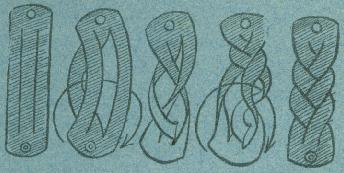
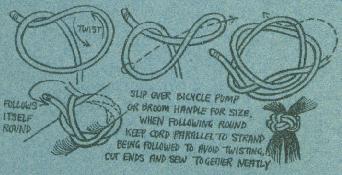
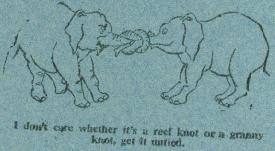
I dont care whether its a reef knot or a granny knot, get it untied!
|



